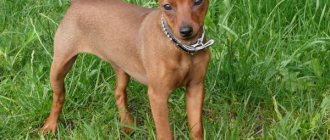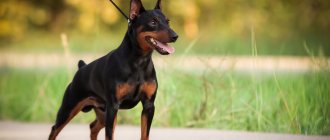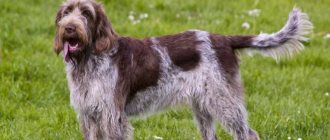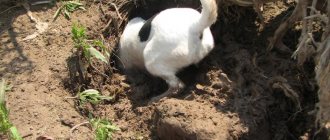Labrador: the pros and cons of the breed need to be carefully considered before purchasing. First you need to decide for what purpose you are getting a dog. For example, if you need a guard, then this breed is not the best option. Since retrievers are devoid of aggression and treat all people with love. On the other hand, for large families, the dog’s friendliness will be a big plus. Because Labradors happily and tirelessly play with children and will never harm them. We will describe the advantages and disadvantages of the Labrador breed so that you can decide whether to have a Labrador in an apartment . And also whether this breed is suitable for you and your family.
Labrador: pros and cons of the breed in an apartment.
Labrador Retriever breed standard
The description of the Labrador Retriever breed standard is characterized not only by distinctive external characteristics, but also by focusing on the characteristic psychological characteristics of these dogs, their mood and behavior.
The Labrador Retriever is a dog breed with a strong constitution. Representatives of this breed are very athletic, have developed muscles, which allows them to withstand long runs over long distances.
Labradors were originally bred for hunting. Therefore, these dogs must remain light and energetic.
The ideal height at the withers for a male dog is 57-62 cm with an ideal weight of 29-36 kg. Bitches are always smaller than males, and with a height of no more than 55 cm they can weigh up to 31.5 kg.
Excess weight for such a dog can lead to a decrease in its activity.
The head is moderately large (in proportion to the size of the body). It is distinguished by a wide skull, but at the same time it does not have rough lines.
The muzzle is not pointed, the transition from the forehead to it is not clearly expressed.
The top of the head is almost parallel to the line of the nose. The jaw is characterized by a so-called dry structure, that is, the upper lip does not hang, while in general the lips fit quite tightly to the jaw.
The head is located on a strong and muscular neck.
The Labrador's chest is located at the level of the elbows of the front legs and tapers at the bottom for freer movement.
It is not considered a deviation from the standard if the chest is lowered a little lower.
The distance from the shoulder joint to the base of the tail should be equal (in some cases, slightly greater) to the height of the dog at the withers.
The top line of the body of these pets tends to remain straight both at rest and while walking or running. It is also typical for the lower line of the abdomen to be straight, that is, the abdomen is not retracted or hanging.
The length of the paws of dogs of this breed is such that it does not make the Labrador too stocky, but at the same time it cannot be called long-legged either.
The paws are strong, the toes are short, and the pads are sufficiently developed. Dewclaws are usually removed.
In general, the paws are located exactly under the body and are perpendicular to the ground. Thanks to this, the movements of Labradors are easy and free.
History of the origin of the breed
Scientists have still not been able to fully understand the origin of this breed. But there is information that the first dogs came to England from the shores of Canada, more precisely the island of Newfoundland. Therefore, they were originally called by the name of the island and the city of the same name.
There are several theories about the origin of these dogs. According to one of them, they descended from Newfoundland dogs. But Dr. Woods offers another version, according to which the formation of the breed took place on the island and Basque and Viking dogs took an active part in its creation. Life on the island left its mark on the dogs' habits. They love water very much and agree to work either on land or in water.
Newfoundland fishermen needed a four-legged assistant - small so that he could independently get into and out of the boat, equipped with water-repellent wool, with a developed search instinct and high performance.
At that time, two types of animals developed on the island - small Newfoundland dogs and large ones. Large dogs were used as draft force. But at the beginning of the 19th century, they began to be exported from the island for English aristocrats, as large dogs with long hair became fashionable. They kept the original name of the island.
Small dogs were quite miniature, had a short, waterproof coat, agility and energy. They loved water and had a unique sense of smell. They were called differently: Lesser St. Johns, Lesser Newfoundlands, and, which surprises researchers, Labradors.
Large dogs - Newfoundlands - are still representatives of a fairly common breed, and small ones became the founders of modern breeds of retrievers, including Labradors.
The unique qualities of Labradors are their ability to float and their flexible nature, as noted by athletes from England. When the fashion for hunting birds from the pheasant family appeared, representatives of the setter and point breeds were often replaced by retrievers. But then no one monitored the purity of the species, and the owners received offspring from individuals with short and long hair.
Since 1830, small dogs (St. John's, also known as Labradors) began to be exported from the island to England for breeding as a separate breed. At that time, some breeders began to adhere to certain rules, trying to preserve natural data. But many were experimenting, bringing Labradors together with other representatives of the retriever breeds.
At the beginning of the century, Labradors could be seen at English exhibitions. At that time, the name retriever included several types of dogs - long-haired, short-haired, dark chestnut and Norfolk retrievers, which have already disappeared. Later, separate breeds were created for each species, and in 1903, a separate Labrador Retriever breed was registered with the English Kennel Club.
For two decades, several large nurseries have been improving the breed, and their work is the appearance of modern Labrador retrievers.
How dogs are used
Thanks to their friendly disposition and natural desire to please their owners, Labradors have become one of the famous family dogs.
They are widely used in search and rescue, coastal and other services. Their work in psychological support of patients, as guides, is often described. According to the results of a three-year international study, Labrador is recognized as the best for working in customs.
They still remain in demand for hunting game birds. Almost everywhere where balance and perseverance in the absence of any malice are required from a pet, labs have won the palm. According to all owners, they are not suitable for protective guard duty.
Breed characteristics
- Attachment to family. Dogs are very attached to their family and love all its members. They get bored alone and are greeted with joy. The breed is considered the most family-friendly, but the fact that these dogs adore all the people they know and do not know does not give us the right to give the highest score.
- Attitude towards children. Labradors have an excellent reputation when it comes to relationships with children. Yes, they love all children without exception. They do not divide them into friends and foes. With the master's children there can be troubles. They miss them in their absence, greet them joyfully, and are ready to play with them as much as needed. But adults must supervise the interaction between a large dog and a small child.
- Attitude towards strangers. Nobody loves strangers as much as this breed. This is a plus of the breed and its huge minus. Of course, it’s nice when you come to visit and an unfamiliar dog greets you as if he missed you. But the owners of this dog are unlikely to be pleased with such absolute friendliness.
- Security qualities. The breed is not suitable for protection. The dog’s love for people is so great that even the thought does not arise in its head that someone wants to offend the owner and members of his family. The most he can do is bark in warning if someone unfamiliar approaches. After this barking, the dog will most likely happily jump on the stranger and try to lick him.
- Guard qualities. The Labrador is not a guard dog. The dog loves all people, including robbers, intruders and strangers who accidentally enter the house. Everyone who crosses the threshold of the house is beloved friends. The dog will happily lick everyone and may show where its favorite bone is buried. Will not interfere with robbers who want to take something out of the house.
- Hair loss. Dogs shed a lot. You will find your pet's fur every day on sofas, carpets, and clothes. The dog is large, be prepared for a lot of hair. The owners of Labradors are saved with the help of a vacuum cleaner, a thick brush and a furminator.
- General health. The breed cannot be called absolutely healthy. Firstly, serious genetic diseases are often found in dogs: dysplasia of the elbow and hip joints, osteoarthritis, hyperkeratosis, epilepsy. Secondly, the breed is indiscriminate in food and prone to gluttony. Because of this, digestive problems, diabetes, and obesity arise. In addition, Labradors are prone to allergies.
- Playfulness. Dogs are active and playful, especially in puppyhood. They mature late; your pet can remain a puppy at heart for up to 3 years. And behave accordingly, splashing out the puppy’s energy. Labrador owners call them “40 kilograms of uncontrollable happiness.” With proper training and education, this playfulness can be a plus.
- Tendency to train. It is believed that the Labrador is a dog ideal for training. Yes, they can be taught a lot, they quickly remember their nicknames and simple commands. But in order to train a dog to be a guide dog or a rescue dog, you need to train him persistently and patiently for 1-2 years. Behind the apparent ease of training the breed there are years of hard work by dog handlers.
HEALTH
Like most purebred dogs, the breed suffers from some genetic diseases. And the fact that they are one of the most popular breeds makes them more vulnerable. Their friendliness and loving nature make them one of the best-selling dogs.
Some take advantage of this and run nurseries solely for profit. In principle, this is not so bad if they select them well. But the fact that some people keep and raise dogs in terrible conditions is already a problem.
Since for such people a dog is, first of all, a certain sum, they do not care about its health, future and psyche. They are most interested in making as much money as possible and selling the puppy as quickly as possible. Puppies raised in such nurseries have much worse health and an unstable psyche.
Overall this is a fairly healthy breed. Life expectancy is 10-12 years. Like other large breeds, they suffer from hip dysplasia. Some have vision problems: progressive retinal atrophy, cataracts and corneal dystrophy.
There is a small prevalence of diseases such as autoimmune diseases and deafness, which manifest themselves either from birth or later in life. But the most common problem...
Obesity. They love to eat and lie down, which leads to rapid weight gain. Despite all its external harmlessness, excess weight seriously affects the health of the dog. Obesity directly affects the occurrence of dysplasia and diabetes.
A US study concluded that about 25% of dogs are overweight. To avoid this, Labradors need to be fed and walked properly. A healthy dog can swim for up to two hours, has very little body fat and looks fit rather than fat. Osteoarthritis is very common in older and overweight dogs.
Purina conducted a study on the lives of dogs for 14 years. Those dogs whose diet was monitored outlived their peers by two years, which indicates the importance of feeding.
Subtleties of training
Active and strong, Labradors need long walks, games and training. Training dogs of this breed is quick and easy if the training process begins as early as possible. It is easier to train a puppy to obey; smart kids quickly grasp everything new, especially if correct execution is reinforced by giving treats.
The Labrador needs to be socialized in time; the puppy is brought out into the world as early as possible in order to teach it a calm attitude towards people, cars, and other animals. If the socialization process is delayed, then the pet becomes uncontrollable, he frantically breaks on the leash, wanting to get to know everyone he meets better.
A Labrador must be trained from childhood, otherwise it will turn into an uncontrollable dog.
It is especially difficult for owners of male dogs, since already at the age of six months they already have great physical strength and it is difficult to cope with them.
Training a Labrador has several features:
- Dogs of this breed are food eaters , that is, they love to eat and are ready to do the impossible for a tasty morsel. The owner should take advantage of this opportunity during the training process, rewarding the pet for correctly executing the command. By the way, it is this feature of the Labrador that makes clicker training incredibly successful, when the dog is rewarded for desired behavior. The dog, trying to get a treat, becomes inventive and creative, independently inventing new tricks.
- Stubbornness is another striking feature of the Labrador Retriever , which makes it impossible to use violence or physical pressure methods in the training process. The Labrador responds to physical violence with even greater stubbornness, he refuses to follow commands and becomes uncontrollable.
Types of reflexes
A reflex—the nervous system’s response to stimulation—can be conditioned or unconditioned.
Unconditioned reflexes, given by nature, constant and unchanging reactions of the body, include:
- unconditioned reflexes of a newborn puppy (sucking, swallowing, crawling), helping him adapt to the world around him;
- more complex unconditioned reflexes (food, orientation, movement, search, games, sexual, parental).
Unconditioned reflexes serve as the basis for practicing conditioned reflexes, which are so necessary for training dogs..
They, in turn, are divided into natural (formed only in response to the natural qualities of the stimulus) and artificial (those formed as a result of extraneous stimuli).
The reaction to the voice and appearance of the owner is a natural conditioned reflex; it is formed naturally, without effort and does not fade for a long time.
The reaction to the sound of a command, a gesture, a whistle is an artificial conditioned reflex that is slowly formed and without constant training and proper reinforcement quickly fades away.
Dog training is based precisely on the varied use of artificial conditioned reflexes.
Features of care and nutrition
Caring for a Labrador Retriever is not difficult, since dogs of this breed have short hair and do not need grooming. It is enough to comb the animal regularly using a special brush. During periods of shedding, when the dog intensively loses hair, it is combed with a furminator, which quickly and easily removes dead hair and undercoat.
A Labrador's floppy ears should be cleaned periodically using a special lotion or a regular cotton pad moistened with warm water. After cleaning, wipe the ear dry with a paper towel.
The Labrador wears down its strong claws while walking on asphalt or other hard surfaces. If they grow so long that they interfere with the dog’s walking, they are carefully trimmed with a special guillotine or ordinary wire cutters. It is important to keep the area of the claw, where the blood vessels and nerves pass, intact; for this, trimming is carried out millimeter by millimeter.
Command training
Many believe that a Labrador is an intelligent dog that does not need education and training, and for comfortable coexistence with him it is enough to wean the puppy from pestering passers-by and reacting to stimuli. Actually this is not true. After all, in just a few months, a cute baby will grow into a large dog, which is difficult to handle without training.
The list of mandatory commands for a Labrador includes:
- to me;
- near;
- voice;
- sit;
- place;
- lie;
- it is forbidden;
- ugh.
To me
The puppy is called by name, supplemented with the command “Come to me,” and lured with a treat or toy. As soon as the dog approaches, it must be rewarded.
Near
To teach a Labrador this command, the puppy is put on leashes, shown a treat, and asked to follow the person.
Voice
Teaching your Labrador the “Voice” command is not at all difficult. The puppy is seated in front of you and shown a treat, while pronouncing a command. As soon as the dog barks, he is treated to a treat.
Place
This is one of the most important commands, which should be one of the first to be trained. The puppy is placed on the designated bed and left there. When the Labrador tries to leave the bedding, the dog is returned back, not forgetting to say “Place!”
Sit
With one hand the dog is shown a treat, with the other hand the dog is gently pressed on the sacrum, while simultaneously pronouncing the appropriate command.
Lie
It is easier to teach this command from a sitting position. The puppy is seated, and then lightly pulled up by the front paws, while pressing on the withers and saying the command “Lie down.”
It is forbidden
This important prohibition command helps stop unwanted actions. As soon as the puppy starts doing something inappropriate, they pull him by the collar, strictly saying “No.”
Ugh
This command is taught in the same way as “No”. In order not to confuse the puppy, only one of them is practiced with him.
Labrador Retriever Color Types
The coat of Labradors is short and comes in a variety of colors: white, black, brown, yellow.
Whatever color the pet is, it should be uniform.
Black and yellow Labradors have black noses and eyes.
The brown (chocolate-colored) representative of this breed is distinguished by its brown nose and hazel eyes.
Deviations from these parameters according to the standard are unacceptable.
There may be brown Labradors with black or very dark eye color, which is not desirable, as it gives the dog an angry or aggressive expression.
Millions of fans around the world know for sure that Labradors cannot be angry and aggressive.
Advantages of the Labrador Retriever breed
Labradors deserve their popularity not only for their friendly disposition. They are excellent swimmers, hunting assistants, and have a sense of smell that has virtually no analogues among domestic dogs.
For example, a German shepherd copes with search activities 25% worse.
Labradors are very smart, they are used in the police service (usually for searching and finding missing things, weapons, drugs, banknotes), and they cope well with the role of guides for the blind.
And this is not the entire list of amazing, useful and important qualities of the Labrador.
According to research conducted in the United States, these dogs are among the four most popular breeds worldwide.
How was such a universal breed formed? Was she always so loved and was she always such a good friend to man?
How to prepare the house
Labradors are one of the famous dog breeds. If you need to choose one word as a description, then this word would be friend.
The puppy will need:
- Place to sleep and mattress;
- Feeding area;
- Stock of special food;
- Bowls;
- roulette leash with collar;
- Toys;
- First aid kit.
Before bringing a puppy into the house, you need to remove carpets from the floor, remove all small objects, needles, threads that the baby can swallow, and securely hide electrical and telephone wires, chemicals and shoes. It is important to immediately train the puppy to go to the toilet, and not allow him to do things anywhere.
Who is the breed suitable for?
- Owners of a country house or dacha consisting of a house and a grass lawn. Fresh air, grass and plenty of free space are paradise for a Labrador. He will be able to run around the site having fun, without the risk of ruining anything.
- Active families with teenage children. Families who love active outdoor recreation, sports walks, hiking, cycling and water recreation - this is the best thing you can think of for a Labrador. And with older children, dogs quickly find a common language, can play with them for a long time, and follow their commands.
- Energetic seniors. Labrador is most suitable for energetic and relatively healthy retirees. Dogs need constant contact with humans - a pensioner does not go to work. Older people need walks in the fresh air - dogs will be happy to keep them company. The only condition is that the dog must undergo a training course so that it can be easily controlled.
Nuances of education
Well-planned training is 50 percent of success. The trainer needs to remember that if there is an excess of feelings, it is difficult to achieve the dog’s obedience. And the owner’s persistence will cause emotional suppression of the pet.
Before the lesson, the Labrador should have played enough and be a little tired. A leisurely walk on a leash will distract your dog from entertainment. After 10-15 minutes you can try to call your pet. If the Labrador immediately responds to the call, it is ready for training, but ignores its nickname - the nervous system has not yet returned to its normal state.
For boys
When working with male dogs, you need to learn how to keep the dog's attention on you. The owner should give priority to dogs running past.
The hardest thing for Labradors - boys - is to resist the temptation to be distracted by a playful lady during the period of heat.
Girl
Bitches have their own difficulties. The trainer has to adapt to frequent mood swings or learn to stabilize the emotional swings of the four-legged animals. Instability is associated with hormonal levels.
Expert opinion
Anna Abramenko
An avid dog lover. Experience in veterinary medicine since 2009.
Ask a Question
When your pet becomes distracted, it is better to postpone training. The best option is to start raising a girl at 2 months.
Who is the breed not suitable for?
- For avid gardeners who spend the whole summer in their beds growing crops. A Labrador at a dacha with beds and greenhouses will have to be kept on a leash - the dog will not appreciate your efforts, it will happily run around the entire plantation, pulling something out of the beds. If you have such a dacha, get yourself a small lap dog.
- Busy people. Dogs are too attached to their owner and need constant communication. Alone they go crazy. Out of boredom, the dog will “communicate” with your things that smell like you. Don’t be surprised that after this “communication” things will become unusable. Take a closer look at dachshunds, French bulldogs and greyhounds.
- Families with very young children. Yes, the breed is great with children, but a large dog may not calculate its strength and, in a fit of play, injure the baby. In addition, the dog is irritated by too noisy and fussy little ones. Such families can be advised to get a well-trained cocker spaniel.
Is it worth buying an adult dog?
If a family decides to take an adult Labrador into their home, they must first weigh some circumstances:
- Have the new owners ever interacted with similar breeds of dogs?
- Observe the pet in a familiar environment;
- Find out if the Labrador has had contact with children and pets;
- Does she have any bad habits (she may have to stop going to the toilet at home);
- See how the dog behaves on the street, how controllable it is.
How much does a Labrador Retriever puppy cost?
The appropriate age for selling a puppy is 1.5 months. No self-respecting breeder will offer offspring that have not reached this age. The cost of a purebred puppy with a kennel mark, pedigree and all the necessary documents varies from 30,000 to 65,000 rubles. Naturally, the price depends on the class of the dog.
You can purchase a purebred puppy, but without a puppy card, for 10,000-12,000 rubles. Puppies offered much cheaper in private advertisements are a real “pig in a poke” and no guarantees can be obtained about their belonging to the breed.
The Labrador Retriever is an ideal dog for a large, friendly family. He will treat everyone, without exception, family members well. However, such a pet needs attention, care and love.
Main questions
Will a Labrador be able to protect its owner in case of danger?
No. The breed is not capable of attacking humans; it was bred as a rescuer to help fishermen. A mentally healthy dog will not be able to protect you. If you need a bodyguard, get a German Shepherd, Rottweiler or Doberman.
Is it possible to keep Labradors year-round in an outdoor enclosure?
You can, if you yourself are ready to live there with him. The breed is not intended for street keeping. These are domestic dogs, they need constant communication with the owner and his family. If you need an open-air dog, get a German Shepherd or Alabai.
Why do Labrador Retrievers constantly shed?
You had to prepare for this when you decided to get a Labrador - they shed all year round. Experienced owners advise:
- make sure that the dog has no health problems;
- buy a vacuum cleaner and vacuum regularly;
- during seasonal molting, use a furminator;
- get yourself a different breed.
Do Labradors bark often?
The breed does not belong to the “empty-haired” breed. A dog may bark warningly to get your attention or to warn you that a stranger is coming. Frequent barking is a sign that your pet is bored.
Who is better suited to be a pet – a male or a female?
The peculiarities of the breed are that Labrador boys are gentle, loyal and loving. They make excellent companions. Bitches require increased attention and care more about themselves and not about the person.
During a walk, our dog always tries to pick something up from the ground and eat it. I already had stomach problems because of this. I'm afraid I'll get poisoned someday. Is it possible to stop a Labrador from picking up from the ground?
Yes, it's a breed problem. All Labradors are big gluttons, so they love to pick up everything that seems like food to them. Of course, you can only walk with a muzzle - this is the first solution to the problem. The second is more preferable; the dog needs to be systematically weaned from this harmful habit.
Experienced dog owners recommend using an empty aluminum Coca-Cola can. It is half filled with small pebbles or coins. When a dog picks up something while walking, they give the command “No!” and throw this rattling can towards the dog. There is no need to try to hit - the sound scares the dog.
My husband wants to give his two-year-old son a Labrador. They are said to be great with small children. Isn't this dangerous?
If you need a second child in the family, let him give it to you. The first thing you will have to do in the morning is not to feed the child, but to clean up after the puppy. The idea is not the best. A Labrador will not harm a child, but a small child may harm a puppy. In addition, the breed does not belong to the category of long-livers; the child will not have time to enjoy communication with the dog.
We are going to the sea with the whole family, is it possible to take the dog with us?
You can travel with Labradors, he should like the sea. The breed loves water and swims well. If your dog likes the sea, it will keep you company while swimming.
What color should a purebred puppy be?
Dogs of this breed come in only three colors: yellow, black and chocolate. No other colors are allowed. If they want to sell you a puppy of a rare color (golden, brindle), this is not a Labrador.
What is the best thing to give a Labrador puppy during training?
His usual food is best. You can feed your Labrador the entire ration during training, so he will understand that food must be earned. This will increase his motivation to learn.
How to wean an adult Labrador from sleeping in a bed?
The breed is very intelligent and easy to train. If you need to wean your dog from sleeping in the bed, say the command “No!” every time the dog jumps into it. Prepare and show him a comfortable, large and soft bed. Give him his favorite treat when he goes to sleep there.
How to stop a puppy from biting the leash? Our baby is 5 months old, every walk is a disaster. Doesn't let him put on a leash, bites him, jumps after him, chews him, gets very excited.
In this way he expresses joy and anticipation of the walk. We need to educate. Every time say the command “Fu!” He must understand that the leash is not a toy. Don't go for a walk until he calms down. The more often you use the leash, the faster your baby will get used to it.
Why does my Labrador often run around like crazy with his back legs tucked in? He is OK?
Calm down, the dog is not crazy! All Labradors do this from time to time. This is an uncontrolled release of energy. Try not to get into the trajectory of his movement, remove small children from the dog’s path so that he does not accidentally injure him.
We adopted a Labrador puppy, and two months later cracks and blood appeared on his nose. What could it be?
The diagnosis must be made by your veterinarian, but the descriptions suggest that it appears to be hyperkeratosis. The pathology is common in some breed lines. It is inherited and cannot be completely cured.
They say that black Labradors are more aggressive, is this true?
No that's not true. There is no dependence of the aggressiveness of an animal on its color. Aggression is the result of mistakes in breeding and education.
If you haven’t found the answer to your question, we suggest you read our article to the end - in it we tried to collect all the most important and interesting things about the Labrador Retriever breed.
Health
The endurance of dogs is high, but no one is immune from disease. Labradors can get sick for the following reasons:
- Indigestion. The main signs are nausea, diarrhea, and lack of stool; these may indicate inflammation or poisoning. If these symptoms occur, you should contact your veterinarian.
- Injuries. For fractures and bruises, you should immediately contact a veterinarian. An open wound should be treated immediately. Stretching requires a reduction in loads.
- Pregnancy or false pregnancy - both with real and false pregnancy, you need to contact a veterinarian;
- Hereditary diseases. Many individuals suffer from joint or bone diseases. Diseases are more often inherited.
Diabetes or obesity are common, and heart problems are sometimes seen. But proper care, proper nutrition and distribution of physical activity will provide your pet with 10 to 14 years of healthy life.
What to feed a Labrador
The owner must carefully plan the dog’s diet - large breeds need a lot of food, but you need to control the portion size so as not to overfeed the dog. The volume of the daily portion is calculated taking into account the weight and age of the dog.
Natural feeding
The daily portion for an adult pet is 900 -1400 g. When breastfeeding, 3/4 of the daily portion should be meat and meat products, 1/4 should be cereals. The meat should be lean: horse meat, veal, turkey, rabbit or chicken. Give preference to stringy pieces. Raw meat is pre-frozen and doused with boiling water before serving.
In addition to meat, a dog’s diet includes:
- boiled offal;
- raw tripe;
- lean sea fish;
- cereals: buckwheat, oatmeal, rice;
- rye crackers;
- vegetable oil;
- cottage cheese, kefir and yogurt;
- cheese;
- quail eggs;
- vegetables and herbs;
- vitamin and mineral complexes.
Important!
Be sure to follow the drinking regime - fresh water should be freely available to the dog around the clock.
Ready-made feed
The daily intake is calculated in accordance with the instructions on the food packaging. On average, an adult dog should eat 350-500 grams. It is best to continue feeding the puppy the food the breeder gave the puppy. When choosing ready-made food, you should give preference to high-quality brands for large active dogs (holistic, super-premium). They have a balanced composition, and the formula contains all the necessary vitamins and minerals.
The best food for Labradors
- Acana Grass-Fed Lamb is a high-protein dry food with a hypoallergenic formula based on raw lamb meat, ideal for large and active dogs. Proteins – 31%, fats – 15%. Ingredients: lamb, raw lamb liver, green peas, lentils, raw tripe, lamb cartilage and kidneys, chickpeas, apples, seaweed, pumpkin. The formula is enriched with beneficial herbs and spices, contains vitamins and minerals;
- Eukanuba Breed Specific Dry Dog Food For Labrador Retriever Chicken is a pelleted diet designed specifically for the needs of the Labrador Retriever breed. The formula is based on chicken meat, chicken fat, fish meal, barley, corn, beet pulp. Proteins – 23%, fats – 13%. The food belongs to the super-premium class. Contains a complete vitamin and mineral complex;
- Advance Labrador Adult - dry formula of breed food for adult dogs includes: chicken, dried eggs, barley, corn, green peas, fish oil, yeast. The food is enriched with minerals and vitamins necessary for the growth and development of Labrador. Proteins – 29%, fats – 14%. The optimal calorie level controls the animal's weight;
- Hill's Nature's Best Canine Adult Large Breed/Giant dry - granule food for adult dogs of large breeds based on turkey and chicken meat. Protein content – 22.7%, fat – 14.5%. The food is enriched with a complex of antioxidants. Contains chondroprotectors, L-carnitine, taurine, vitamins and microelements. The formula helps maintain the dog's optimal weight;
- Royal Canin Labrador Retriever Adult is a dry breed food for active dogs aged 5 months and older. The composition is based on dry poultry meat. Contains grains. Proteins – 30%, fats – 13%. Enriched with natural antioxidants, contains L-carnitine, glucosamine and chondroitin.











